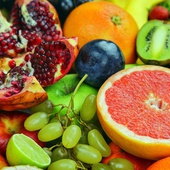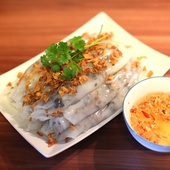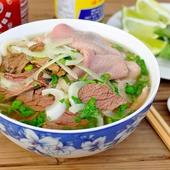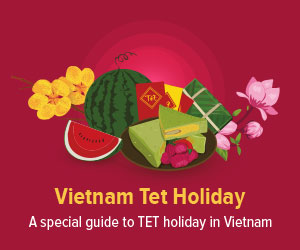Xoi (Steamed Glutinous Rice)
Wandering around Vietnam's streets early in the morning, travellers can easily catch sight of a scrum of people gathering at a corner, waiting impatiently. Move a closer step, we can realize in the middle of the crowd, sits a woman with a small basket, continuously serving some strange food onto the banana leaf. That is “Xoi”- one of the most popular Vietnamese “fast food”. Photo: vietnamnet.vn
Photo: vietnamnet.vn
What is Xoi?
“Xoi”; or “glutinous rice”, “sweet rice”, “sticky rice” in English; can be found in many Asian dishes, especially in the South East Asia areas. To cook “xoi”, Vietnamese often soak the glutinous rice for around four hours until the grains have absorbed enough water. Then, the rice will be drained and steamed dry so that the grains can remain as the whole, soft but not mushy, sticking together in a lump. Photo: 24h.com.vn
Photo: 24h.com.vn
Sometimes people can also make “xoi” using electric rice cooker, with the same method when cooking regular rice. However, the grain will break down under the direct heat, becoming glue-like and soggy.
“Xoi” can be eaten at any time of the day, but typically, Vietnamese often choose it as a cheap and scrumptious dish for their morning meal.
Variety of Xoi
From one main white plain”xoi”, there are nearly hundreds variations have been created. Normally, sticky rice can be steamed together with other seeds like mung bean (black and red mung bean are also included), corn, peanut, etc.
As many other Vietnamese street food, “xoi” is a “enjoy it in your own way” cuisine, because one is free to eat with whatever he wants according to his personal taste!
For breakfast, people usually eat “xoi” with “ruoc”- stringy, salty dried pork; “muoi vung- salty sesame and peanut; or even with only deep fried shallots and a tablespoon of vegetable oil. It will cost around VND7000-VND10000 for a simple set of “xoi”. Others may serve their “xoi” with braised egg, braised pork, ‘”lap xuong”- Chinese-like sausage, “gio cha”- Vietnamese pork pies, or chicken breast, chicken drumstick; but the price will be higher, from VND15000 up to even VND50000.
Different areas have various kinds of “xoi” with distinct taste. In the mountainous area of Northern Vietnam, the ethnic minority are very proud of their “five-color xoi”. “Xoi” is cooked with special local herbs which originate the colors of red, black, purple, and yellow. No food coloring using, all are natural and good for your health. Photo: dienmayxanh.com
Photo: dienmayxanh.com
Hanoi, the capital, is famous for its “Xoi com”- “young green sticky rice”, a delicacy that is made only in autumn. Together with white coconut, the grains are so sweetly scent that it will leave a lasting flavor. In Southern Vietnam, coconut milk and panda leaves are also added, which makes “xoi” a sweet dessert fitting perfectly for supper. Photo: pasgo.com
Photo: pasgo.com
See the most popular types of Xoi here
Where to try Xoi?
Most of the time, “xoi” can be purchased in small roadside vendors in the morning. Let’s come back with the sight of the woman selling “xoi” on the street that we have just seen. Everything she needs for her vendor is s bamboo basket fully packed with “xoi” (which is kept warm by a thin blanket) and some small bottles containing “ruoc”, “muoi vung”, deep fried shallot...to fulfill all the demands of the customers. Most of the sellers will sit at the same place every day, normally in front of school or office gate, or in corner of the streets. Customers will come, calling down orders and they will be served within three minutes. Yes, only three minutes, that is the reason why “xoi” is considered one of Vietnamese fast food!
Watching people buying “xoi” in the street is far more than interesting. The seller is in the middle, with all the customers standing around, waiting for their turn. Customers can check on their portion while the seller serve, noticing whether the seller diminishes the size of the portion or not, or trying to have more “xoi” with the same price. They express their requirements directly with “extra this”, “no no no not so much of that”, and the sellers magically always meet their satisfaction.
A portion of “xoi” is often thrice-wrapped, with one layer of banana leaf, another layer of recycle paper or old newspaper, and one plastic bag covered outside; so as to keep it warm while eating.
“Xoi” plays an essential role in Vietnamese’s life, which is an indispensable dish in many rituals. On Tet holiday (the Lunar New Year in Vietnam), every family will cook “xoi gac”-sticky rice with momordica, with the belief that its appealing red color will bring good luck to this whole new year. Students also have mung bean “xoi” on the day before the test in the hope of passing with high scores, and avoid peanut “xoi” for fear of misunderstanding the requirements of the test ( in Vietnamese, mung bean means “do”- passing”, and peanut means “lac”- misunderstanding).
Some contains corn while the other peanuts. Some is colored by black beans while others flavoured with salted seasame seeds. “Xoi” is one of the most filling options for a meal and the price is hardly over 20,000VND (about a us dollar). It is served hot or cold, wrapped in banana leaf or plastic cover.
Most Vietnamese have “xoi” for breakfast and all local markets will have at least one lady with some baskets selling this specialty. While the presence of “xoi” in local market seems permanence, more and more restaurant is specializing in “xoi” and others attempt to include “xoi” in their menu. If you visit Vietnam, try “xoi” for any of your meal to feel the fragrance of lotus or mung beans and to enjoy Vietnamese rice in an off-the-beaten-path way.

Vietnamese Fruits - An Overview
Being geographically located in the tropical zone, Vietnam is truly a heaven when it comes to fruits.

Vietnamese Cakes - A Closer Look At Vietnam's Most Varied Food
An overview to the different types of cake in Vietnam.

Vietnamese Noodles - An Overview
An introduction to Vietnamese noodles.








